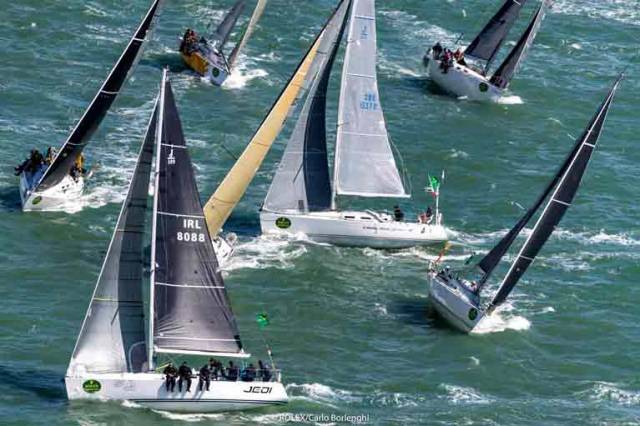The final results of the Rolex Fastnet Race 2017 show that Kenneth Rumball with the Irish National Sailing School’s J/109 Jedi has won in IRC 3B, where third place has been taken by ISORA’s J/109 Mojito. And RORC Commodore Michael Boyd has been second in IRC 2 with the First 44.7 Lisa.
Clearly, the Irish contingent in this great classic have had a successful time of it despite some extraordinary fluctuations of fortune. But how are such twists of fate to be explained? The Rolex Fastnet Race of modern times can be analysed by the latest technology in so many different ways that, even with the best computers, it can sometimes take much longer to deduce what precisely happened than it took in real time out at sea. So perhaps if we just select a few salient facts, we might be able to get a better overall picture. W M Nixon gives it a try.
If the Rolex Fastnet Race 2017 had finished at the Fastnet Rock itself, with the fleet adjourning into Baltimore and Schull to have a party or three, there would have been much for the builders of the successful JPK range to celebrate. And several crews with strong Irish connections would have been quite right in partying to beat the band as well.
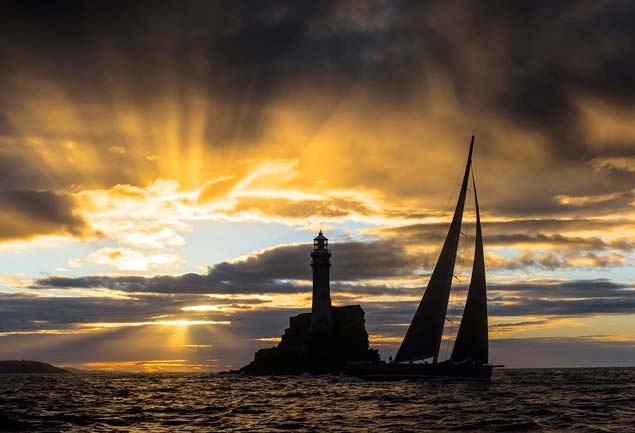 Glad morning again….the biggest boat in the race, the JV 115 Nikata (Tom Brewer) rounds the Fastnet Rock at 7 o’clock on Tuesday morning. Photo Rolex
Glad morning again….the biggest boat in the race, the JV 115 Nikata (Tom Brewer) rounds the Fastnet Rock at 7 o’clock on Tuesday morning. Photo Rolex
For after an increasingly rugged windward slug the whole way from the start, the overall leader at the Rock was 2013’s winner, the French JPK 10.10 Night & Day, whose achievement was further heightened by the fact that she was being sailed two-handed by father-and-son crew Pascal and Alexis Loison.
And second overall was another seasoned French campaigner, Noel Racine with his JPK 10.10 Foggy Dew. But it’s when we get to third slot that Irish eyes light up, as it was comfortably held by our own Paul Kavanagh’s Swan 44 Pomeroy Swan. She was all of 11 minutes ahead of yet another French boat, Giles Fournier’s J/133 Pintia, which was fourth overall at the Fastnet.
But close behind in sixth overall was the classic S&S 41 Winsome (Harry Hiejst) helmed by Laura Dillon, Irish Champion Helm in 1996. Winsome had experienced her ups and downs since the start, but when it comes to grown-up windward work, there are still very few boats that can do it like the best 1972 Sparkman & Stephens design, and Winsome had been making hay since Land’s End, marching her way up through the fleet.
However, before we move on to see how these leaders-at-the-Rock finally ended in the rankings in Plymouth, casting an eye further down the Fastnet times continues to be rewarding, as we find that the hot ISORA J/109 Mojito (Peter Dunlop and Vicky Cox) was lying 9th overall as she made the turn on Wednesday morning at 7 o’clock, and Kenneth Rumball in command of the Irish National Sailing School’s J/109 Jedi was only a quarter of an hour later, correcting into 11th overall, which put him one place ahead of our RORC Commodore Michael Boyd in the First 44.7 Lisa.
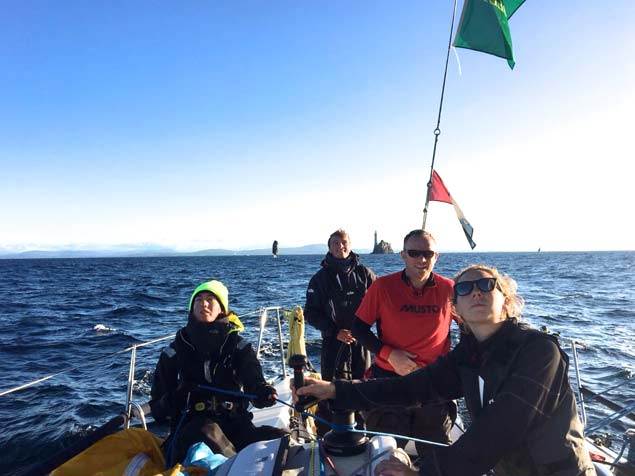 Cheerful times aboard Jedi after rounding the Fastnet, where she’d been placed 11th overall of the entire 312-strong IRC fleet. Photo INSS
Cheerful times aboard Jedi after rounding the Fastnet, where she’d been placed 11th overall of the entire 312-strong IRC fleet. Photo INSS
 Nikata at the start with three of the Volvo 65s. The new Volvo boats had a very close Fastnet Race, with Dongfeng winning by 54 seconds from Mapfre. And they’re being kept busy – on Thursday they raced away from Plymouth, bound for St Malo and Lisbon
Nikata at the start with three of the Volvo 65s. The new Volvo boats had a very close Fastnet Race, with Dongfeng winning by 54 seconds from Mapfre. And they’re being kept busy – on Thursday they raced away from Plymouth, bound for St Malo and Lisbon
Yet of the boats which are now figuring at the top twelve of the overall leaderboard in Plymouth, only Pintia, Lisa and the Grand Soleil 43 Codiam were in the top twelve at the rock. The JNA 39 Lann Ael 2 (Didier Gaudoux), which seemed to come out of nowhere at the finish to snatch the overall lead from Ron O’Hanley’s Cookson 50 Privateer, was only 29th at the Fastnet Rock.
As for Privateer, she was well back, in 40th. Yet the way the winds, weather and tides developed for the final 247 miles from Fastnet to finish meant the placings continued to be shaken up until the very end, and it looked for long enough as though Privateer has the big prize until Lann Ael 2 came out of the dark in the small hours of Thursday morning, and took it.
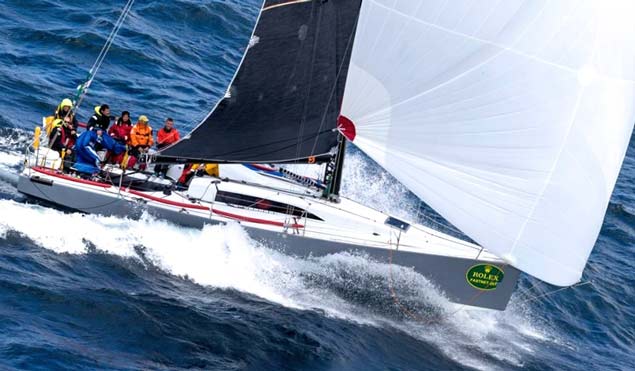 The JDA 39 Lann Ael making knots on the way to Plymouth
The JDA 39 Lann Ael making knots on the way to Plymouth
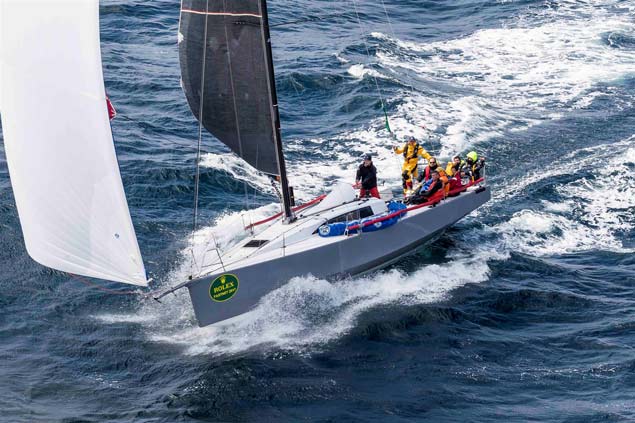 The look of a winner. Lann Ael was not showing up on the Race Tracker for some tehnical reason, but she was very definitely right there, zooming past the Isles of Scilly on her way to the overall win
The look of a winner. Lann Ael was not showing up on the Race Tracker for some tehnical reason, but she was very definitely right there, zooming past the Isles of Scilly on her way to the overall win
This means that for the third time in a row, the overall Rolex Fastnet Race winner is French. There’s no doubt about it, but La belle France is on a roll on the offshore scene these days, for if they aren’t themselves actually sailing the winning French-built boats, the chances are they were the designers and builders.
This is an impression which is reinforced by going into the class details, and particularly among the smaller boats. In IRC 3 it’s French-produced boats dominant, with two JPK 10.80s – Dream Pearls and Timeline - separated by just two minutes on corrected time, with Timeline having finished first, but losing through a higher rating.
It’s not until we got down to 9th place in IRC 3 that we break the French stream, and even here the 9th placed Irish J/109 Jedi – which wins IRC 3B - may have been designed in America by the Johnstone team, but I’ve a feeling she was built in France.
The placing means that Jedi got through Mojito in the sometimes wild romp back from the Rock, but all around them positions were changing, and the solid Sparkman & Stephens veterans such as Pomeroy Swan and Winsome, which had shown so well on the dead beat, were losing time all the way while the loghter boats were surfing.
However, while the two overall leaders at the Fastnet, Night & Day and Foggy Dew, slipped down the overall rankings, they maintained their class leads in IRC 4, and let it be noted that Poweroy Swan wasn’t entirely out of the hunt, as she is 4th in IRC 4. But Winsome slipped back to 12th in class.
It’s ironic that of the two former Champion Helms of Ireland whom we know to have been doing the Rolex Fastnet Race 2017, one of them – Laura Dillon – was in a boat which went superbly to windward but wasn’t so competitive downwind, while the other. Nin O’Leary, was in a boat which seemed woeful to windward, but was fastest of the lot as soon as she bore off at the rock.
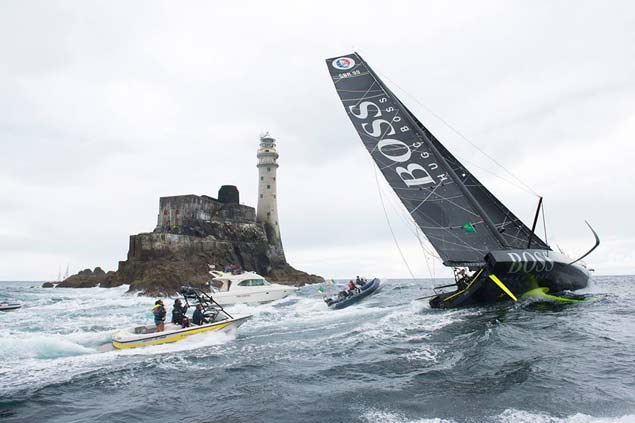 Hugo Boss finally reaches the Fastnet Rock at 3.0pm on Tuesday. Within minutes, she was speeding downwind, up on her foils and making 22 knots
Hugo Boss finally reaches the Fastnet Rock at 3.0pm on Tuesday. Within minutes, she was speeding downwind, up on her foils and making 22 knots
Quite why Nin’s co-skippered IMOCA 60 Hugo Boss was just so poor to windward, even by comparison with other IMOCA 60s, is something for further study. But she’s very much a boat for the wide open spaces, and the relatively short 247 miles from the Fastnet to Plymouth wasn’t nearly long enough for her foils to pick her up properly, and let the big black boat really go like the wind.
It was clearly a race of horses for courses, and while it might be going too far to describe Hugo Boss as a one trick pony, in a complex race like this there were some superb all-round boats which gave a master-class in successfully dealing with a wide variety of conditions and finishing with a mileage which suggested that some other boats were sailing a different race entirely.
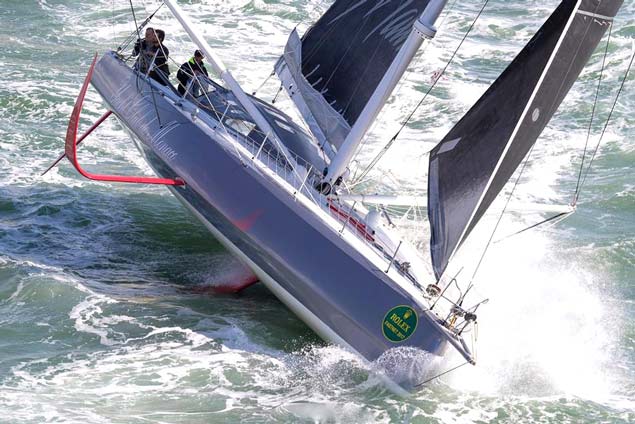 The Yacht Club de Monaco’s IMOCA 60 Malizia placed third in class
The Yacht Club de Monaco’s IMOCA 60 Malizia placed third in class
To re-phrase the great Damon Runyon, the race may not always be to those who sail the shortest distance, but that’s the way the smart money bets. However, the smart money isn’t always completely right. The Fastnet Race course is somewhere between 603 and 608 miles (those pesky Traffic Separation Zones must have changed the classic distance), and it’s of interest to note that the boat which was recorded as sailing the fewest miles, the Italian Mylius 15E25 Ars Una which placed 11th overall, got round in just 655 miles.
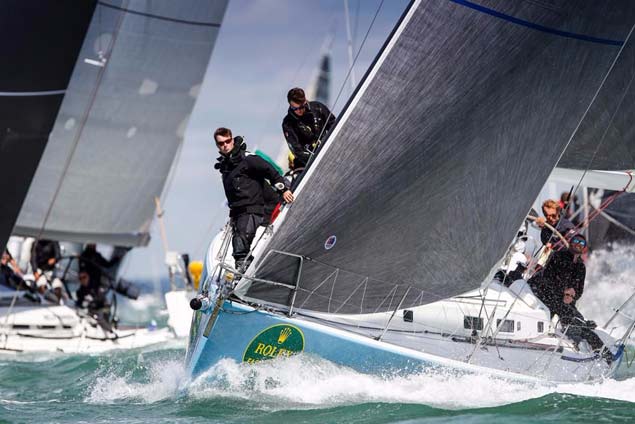 The French J/133 Pintia (Gilles Fournier) at the start. One of the most consistent boats in the fleet, she was well placed overall at the Fastnet, and went on to win Class 2 while placing fourth overall at the finish
The French J/133 Pintia (Gilles Fournier) at the start. One of the most consistent boats in the fleet, she was well placed overall at the Fastnet, and went on to win Class 2 while placing fourth overall at the finish
But Winsome, back in 75th overall after being so handsomely placed at the rock, got round in only 656 miles. She pointed higher than most other boats, and made the right tactical choices on the open water outward bound windward leg. But coming back on the fast run, her classic hull shape militated against her no matter how neat a course they sailed.
The detailed results are here
As for the winner Lann Ael 2, she sailed 662 miles, but for the Fastnet-Plymouth stages she had conditions which clearly suited her perfectly, while the Cookson 50 Privateer sailed all of 687 miles, but she sailed them so well she retained second overall. And the great pioneer, the pathfinder in the lead on the water and testing condtions for all those astern, was George David’s Rambler 88. She may have taken line honours in convincing style, but she sailed an astonishing 730 miles to do so, and slipped back to 65th overall when the basic sums were done.
These sums will be re-worked for a long time yet, for this was one very special Rolex Fastnet Race. Our own Michael Boyd captured it so perfectly in his role as Commodore RORC, shortly after he had finished to take second in class, that it’s worth re-running the vid we posted last night, for he did us proud.
Read all of Afloat.ie's 2017 Fastnet Race coverage here



























